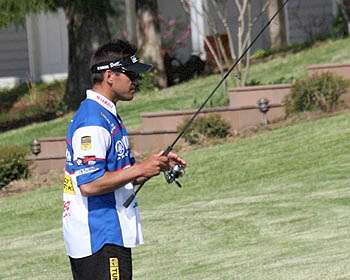
There are certain things in bass fishing that really don't seem that important until, in a split second, they spell the difference between success and failure. A poor knot or a dull hook is a recipe for heartbreak, for example.
Such is the case when it comes to properly setting the drag on your reel. You don't really realize how important it is, until you need it. Overlook this simple piece of equipment, and you're either left with a broken line dangling from the end of your rod or a weak hook-set that doesn't generate a hookup.
For Elite Series anglers like North Carolina's Dave Wolak, developing a system for ensuring the proper drag settings on both spinning and baitcasting reels is an important step that he never overlooks when hitting the water.
When setting his drag, Wolak first takes into account the type of line that he is using. If he is throwing braid, the initial drag setting is easy to achieve. "I'd be lying if I told you anything other than that I crank my drag down as tight as possible when using braid," he admits.
Wolak explains that when he is making long casts with a jerkbait or topwater on braided line, he wants to apply as much pressure as possible on a long distance hook-set. However, after the hook-set, he often adjusts his drag. "I'll often loosen the drag a little because I don't want to rip a hole in the bass' mouth," he explains.
When it comes to fishing monofilament and fluorocarbon lines, the 2005 Rookie of the Year sets his drag just a few clicks lighter than when he is fishing braid. It all comes down to reducing slippage. "That's the most important thing," Wolak opines. "If you're setting the hook and you can hear your drag slip, you're not applying as much pressure on the hook-set as you possibly can."
In the rare instances of a jarring strike close to the boat, backing off the drag just a little when fishing monofilament and fluorocarbon allows for just enough slippage to reduce the chances of a break-off. Just as with braid, Wolak will back off the drag during the fight to ensure the hook doesn't tear a hole in the fish.
When fishing with spinning tackle, Wolak sticks with his mantra that tighter is better. "Even if I'm fishing a drop shot on spinning tackle, I don't ever set the drag loose," he explains. "Typically, in those situations I'm fishing in deep water with a light rod so I want to be able to control the amount of pressure that I apply on the hook-set. After setting the hook, I'll back the drag off before the fish starts going ballistic."
During the course of fighting a big fish on spinning tackle, Wolak often peels line from his reel with his free hand to reduce the chance of a break off. "Sometimes the bass is more aggressive that you think, so manually peeling line gives the bass more room to surge," he says.
The "peel and play" tactic paid off last year on Smith Mountain Lake when Wolak hooked a 4-pound smallmouth that frayed his light line on a stump. "I knew my line was stressed, so I just kept peeling line with my free hand and letting the fish surge. It took longer to land, but it was a fish that I needed."




